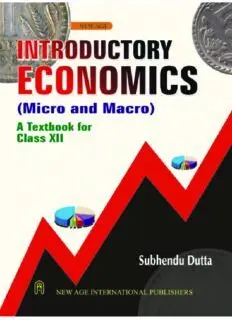
Introductory Economics (Micro and Macro): A Textbook for Class XII PDF
Preview Introductory Economics (Micro and Macro): A Textbook for Class XII
THIS PAGE IS BLANK NEW AGE INTERNATIONAL (P) LIMITED, PUBLISHERS New Delhi · Bangalore · Chennai · Cochin · Guwahati · Hyderabad Jalandhar · Kolkata · Lucknow · Mumbai · Ranchi PUBLISHING FOR ONE WORLD Visit us at www.newagepublishers.com Copyright © 2006, New Age International (P) Ltd., Publishers Published by New Age International (P) Ltd., Publishers All rights reserved. No part of this ebook may be reproduced in any form, by photostat, microfilm, xerography, or any other means, or incorporated into any information retrieval system, electronic or mechanical, without the written permission of the publisher. All inquiries should be emailed to [email protected] ISBN (13) : 978-81-224-2247-4 PUBLISHING FOR ONE WORLD NEW AGE INTERNATIONAL (P) LIMITED, PUBLISHERS 4835/24, Ansari Road, Daryaganj, New Delhi - 110002 Visit us at www.newagepublishers.com DDDDDeeeeedddddiiiiicccccaaaaattttteeeeeddddd tttttooooo mmmmmyyyyy mmmmmooooottttthhhhheeeeerrrrr LLLLLaaaaakkkkkssssshhhhhmmmmmiiiii RRRRR..... DDDDDuuuuuttttttttttaaaaa (v) THIS PAGE IS BLANK PREFACE I have immense pleasure to bring out the present book which is basically designed to cover complete syllabus of Economics for Higher Secondary second year examination (Class XII) as introduced by the Nagaland Board of Secondary Education from the session 2004–2005. The book will also be useful for the students appearing in class XII examination under CBSE. The introduction of new syllabus has created vacuum in respect of suitable books exactly in conformity to NBSE syllabus. As such the present book has been written particularly keeping in mind the problems faced by students studying economics as a paper under NBSE. The book will equally serve the purpose of students opting either Arts or Commerce stream. The book is written in a very simple language understanding that it is meant for beginners. The book contains two Parts-A and B. Part-A analysis Microeconomics and Part-B deals with Macroeconomics. The new syllabus containing microeconomics and macroeconomics with eleven units in total have been suitably divided into twenty seven chapters. Unit-5 and unit-11 in the contents are meant for CBSE students only. At the end of the book, selected basic economic terms have been included under the heading ‘Elementary Economic Terms’. These are the terms most commonly and frequently used in economics and also in real life. The underlying idea is to provide a student general understanding of economics as a subject more clearly and analytically. Past years examination question papers of the NBSE from 1995 onwards have also been incorporated. I am thankful to my wife Mili Dutta for constant inspiration and my lovely daughter Sneha who has given me much time to work on it smoothly. I am also thankful to my colleagues who have directly or indirectly lent their helping hands. I am very much grateful to Mr. Saumya Gupta (Managing Director), Mr. V.R. Damodaran (Production Editor) and Saba Khan (Development Editor) of M/s New Age International (P) Limited, New Delhi for taking prompt and sincere initiative for publishing the book in a right time. I would always invite critical views and suggestions for improvement of the book from both students and fellow teachers. SUBHENDU DUTTA Department of Economics, Public College of Commerce, Dimapur: Nagaland Email:[email protected] THIS PAGE IS BLANK CONTENTS PART A INTRODUCTORY MICROECONOMICS UNIT-1 1. INTRODUCTION TO MICROECONOMICS 3 What economics is all about? Wealth definition; Welfare definition, Scarcity definition, Subject matter of economics, Positive and normative economics; Questions for review. 2. PROBLEMS OF AN ECONOMY 11 Central problems of an economy, Production possibility curve, Uses of production possibility curve, Opportunity cost; Questions for review. UNIT-2 3. CONSUMER BEHAVIOUR 16 Consumer’s equilibrium—utility maximization, Utility, Total utility, Marginal utility, Law of diminishing marginal utility; Questions for review. 4. DEMAND AND LAW OF DEMAND 21 Meaning of demand, Market demand, Determinants of demand, Demand schedule and demand curve, Law of demand, Assumptions of the law, Why does the law of demand operate? Exceptions to the law of demand, Movement along and shifts in demand curve; Questions for review. 5. ELASTICITY OF DEMAND 32 Meaning of price elasticity of demand, Kinds of price elasticity of demand, Measurement of price elasticity of demand—percentage, total expenditure/ outlay, arc method, geometrical method and revenue method. Income elasticity of demand, Cross elasticity of demand, Determinants of price elasticity of demand; Questions for review. UNIT-3 6. THEORY OF PRODUCTION 41 Meaning of production, Meaning of production function, Returns to a factor and returns to scale, Law of variable proportions, Law of diminishing returns, Assumptions of law, Returns to scale; Questions for review.
